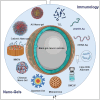Cancer Immunotherapy Using Bioengineered Micro/Nano Structured Hydrogels
- PMID: 37612251
- PMCID: PMC11468077
- DOI: 10.1002/adhm.202301174
Cancer Immunotherapy Using Bioengineered Micro/Nano Structured Hydrogels
Abstract
Hydrogels, a class of materials with a 3D network structure, are widely used in various applications of therapeutic delivery, particularly cancer therapy. Micro and nanogels as miniaturized structures of the bioengineered hydrogels may provide extensive benefits over the common hydrogels in encapsulation and controlled release of small molecular drugs, macromolecular therapeutics, and even cells. Cancer immunotherapy is rapidly developing, and micro/nanostructured hydrogels have gained wide attention regarding their engineered payload release properties that enhance systemic anticancer immunity. Additionally, they are a great candidate due to their local administration properties with a focus on local immune cell manipulation in favor of active and passive immunotherapies. Although applied locally, such micro/nanostructured can also activate systemic antitumor immune responses by releasing nanovaccines safely and effectively inhibiting tumor metastasis and recurrence. However, such hydrogels are mostly used as locally administered carriers to stimulate the immune cells by releasing tumor lysate, drugs, or nanovaccines. In this review, the latest developments in cancer immunotherapy are summarized using micro/nanostructured hydrogels with a particular emphasis on their function depending on the administration route. Moreover, the potential for clinical translation of these hydrogel-based cancer immunotherapies is also discussed.
Keywords: caner immunotherapy; implantable hydrogels; injectable hydrogels; nanogels; nanovaccine; sprayable hydrogels.
© 2023 The Authors. Advanced Healthcare Materials published by Wiley-VCH GmbH.
Conflict of interest statement
The authors declare no conflict of interest.
Figures







References
-
- Aquib M., Juthi A. Z., Farooq M. A., Ali M. G., Janabi A. H. W., Bavi S., Banerjee P., Bhosale R., Bavi R., Wang B., J. Mater. Chem. B 2020, 8, 8507. - PubMed
-
- Jiang Y., Chen J., Deng C., Suuronen E. J., Zhong Z., Biomaterials 2014, 35, 4969. - PubMed
-
- Yu L., Ding J., Chem. Soc. Rev. 2008, 37, 1473. - PubMed
Publication types
MeSH terms
Substances
LinkOut - more resources
Full Text Sources
Medical

